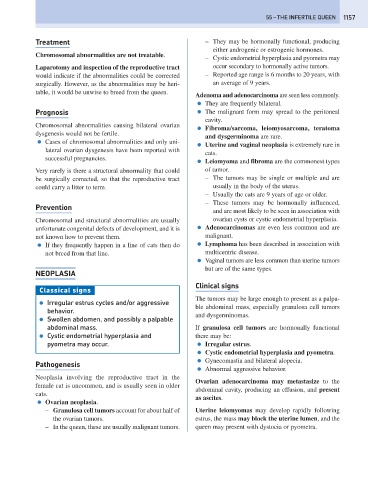Page 1165 - Problem-Based Feline Medicine
P. 1165
55 – THE INFERTILE QUEEN 1157
Treatment – They may be hormonally functional, producing
either androgenic or estrogenic hormones.
Chromosomal abnormalities are not treatable.
– Cystic endometrial hyperplasia and pyometra may
Laparotomy and inspection of the reproductive tract occur secondary to hormonally active tumors.
would indicate if the abnormalities could be corrected – Reported age range is 6 months to 20 years, with
surgically. However, as the abnormalities may be heri- an average of 9 years.
table, it would be unwise to breed from the queen.
Adenoma and adenocarcinoma are seen less commonly.
● They are frequently bilateral.
Prognosis ● The malignant form may spread to the peritoneal
cavity.
Chromosomal abnormalities causing bilateral ovarian
● Fibroma/sarcoma, leiomyosarcoma, teratoma
dysgenesis would not be fertile.
and dysgerminoma are rare.
● Cases of chromosomal abnormalities and only uni-
● Uterine and vaginal neoplasia is extremely rare in
lateral ovarian dysgenesis have been reported with
cats.
successful pregnancies.
● Leiomyoma and fibroma are the commonest types
Very rarely is there a structural abnormality that could of tumor.
be surgically corrected, so that the reproductive tract – The tumors may be single or multiple and are
could carry a litter to term. usually in the body of the uterus.
– Usually the cats are 9 years of age or older.
– These tumors may be hormonally influenced,
Prevention
and are most likely to be seen in association with
Chromosomal and structural abnormalities are usually ovarian cysts or cystic endometrial hyperplasia.
unfortunate congenital defects of development, and it is ● Adenocarcinomas are even less common and are
not known how to prevent them. malignant.
● If they frequently happen in a line of cats then do ● Lymphoma has been described in association with
not breed from that line. multicentric disease.
● Vaginal tumors are less common than uterine tumors
but are of the same types.
NEOPLASIA
Clinical signs
Classical signs
The tumors may be large enough to present as a palpa-
● Irregular estrus cycles and/or aggressive
ble abdominal mass, especially granulosa cell tumors
behavior.
and dysgerminomas.
● Swollen abdomen, and possibly a palpable
abdominal mass. If granulosa cell tumors are hormonally functional
● Cystic endometrial hyperplasia and there may be:
pyometra may occur. ● Irregular estrus.
● Cystic endometrial hyperplasia and pyometra.
● Gynecomastia and bilateral alopecia.
Pathogenesis
● Abnormal aggressive behavior.
Neoplasia involving the reproductive tract in the
Ovarian adenocarcinoma may metastasize to the
female cat is uncommon, and is usually seen in older
abdominal cavity, producing an effusion, and present
cats.
as ascites.
● Ovarian neoplasia.
– Granulosa cell tumors account for about half of Uterine leiomyomas may develop rapidly following
the ovarian tumors. estrus, the mass may block the uterine lumen, and the
– In the queen, these are usually malignant tumors. queen may present with dystocia or pyometra.

